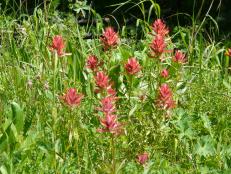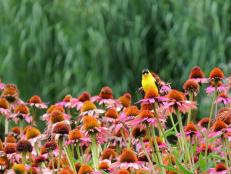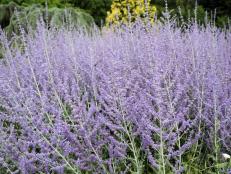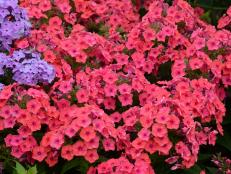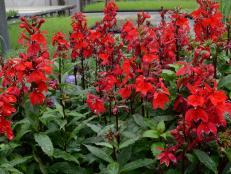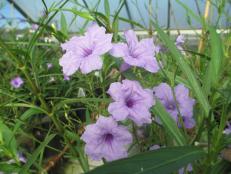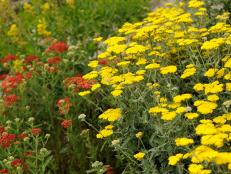Growing Blanket Flower
Low-maintenance blanket flower is a native plant that will fill your yard’s sunny spots with colorful blooms all season long.
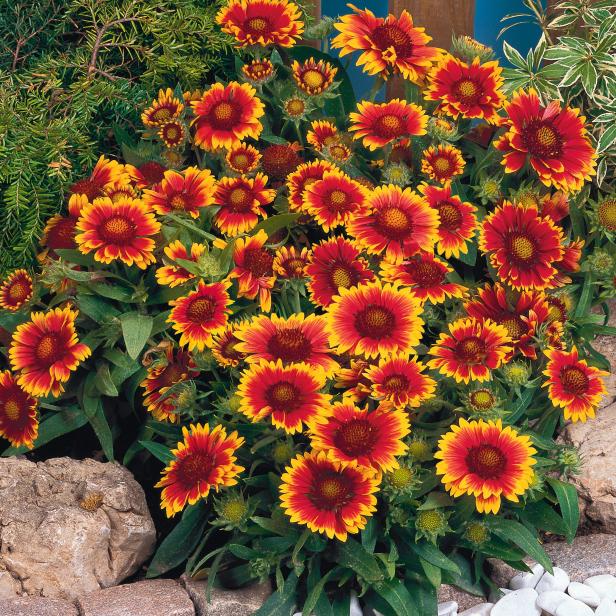
All-America Selections at All-AmericaSelections.org
Blazing orange-red petals edged with gold paint the blossoms on ‘Arizona Sun’ blanket flower (Gaillardia x grandiflora).
A colorful, long-blooming wildflower, blanket flower earns its keep in the landscape with cheerful flowers in sunny shades of gold, orange, yellow and red. Most blanket flowers sold in garden centers are perennials and come back every year. With traits like deer- and rabbit-resistance, drought tolerance and the ability to thrive in lean, sandy soil, it's easy to see why blanket flower care is a cinch. This plant is one tough cookie.
Blanket flower is a North American native plant or wildflower. It goes by the botanical name Gaillardia, a plant group that includes a few key species. Gaillardia pulchella, the first species described in 1788, is an annual and opens 2-inch-wide red blooms with yellow tips. Explorers Lewis and Clark collected perennial Gaillardia aristata in Montana in 1806. It opens fringed flowers in red and yellow blends.
Today the most common type of blanket flower available is Gaillardia x grandiflora, a perennial that blends the best traits of the heirloom plants Gaillardia pulchella and Gaillardia aristata.
Botanical name: Gaillardia
Common Name: Blanket Flower
Bloom Time: Summer to early fall
Bloom Color: Yellow, orange, gold and red
Special Features: Attracts butterflies and hummingbirds
Plant Type: Short-lived Perennial
Size: Grows from 8 to 24 inches tall and 8 to 36 inches wide (depends on variety)
USDA Hardiness Zones: 5 to 9
Blanket flower is a boon to planting beds, thriving with little attention and attracting all kinds of pollinators, including butterflies. These pretty plants tolerate heat and sun, making them a great choice for reliable summer color. They also adapt readily to containers. Learn what you need to know to grow your own crop of blanket flowers.

Terra Nova Nurseries at TerraNovaNurseries.com
Imagine filling a neglected corner of your garden with the bright blooming color of ‘Red Sun’ blanket flower (Gaillardia x grandiflora). Plants form a leafy mound that’s 10 inches tall (14 inches with flowers) and 12 inches wide. Hardy in Zones 3-9.
Where Do Blanket Flowers Grow Best?
Fuss-free to the core, blanket flower actually grows best in soil that's on the poor side. Sandy, fast-draining soil is ideal. Heavy or overly fertile soils won't grow the most gorgeous blanket flowers. In fact, soil that doesn't drain well is the top reason blanket flower dies. If your soil tends to be rich or heavy, you might get the best results growing blanket flower in containers.
How much sun does a blanket flower need? Blanket flower is a sun worshiper. Plants should receive at least six hours of sun each day, but more is better. Although blanket flower plants can grow in light shade, they'll have fewer flowers.
When to Plant Blanket Flower
In most regions, spring is the ideal time for planting blanket flowers. These plants thrive in heat, so wait until all danger of frost has passed. In USDA Zones 8 to 11 you can also plant blanket flower in the fall. Whenever you see plants for sale at local garden centers, that's a clue that it's planting time for your region.
It's possible to grow blanket flower from seed. Start with quality blanket flower seeds and wait for soil to warm up — definitely after any danger of frost has passed. Blanket flower seeds need light to germinate, so simply rough up soil before sowing, toss seeds onto the prepared area and keep it moist until seeds sprout. Blanket flower seeds typically take two to three weeks to germinate.
Most perennial blanket flowers bloom the same year they're planted, but you'll get a better flower show in subsequent years.

PerennialResource.com
‘Arizona Apricot’ blanket flower unfurls 3- to 3.5-inch blooms from early summer into fall. Plants grow 12 inches tall and wide. Hardy in Zones 3-10.
Caring for Blanket Flower
Water
Blanket flower is a prairie wildflower. Prairie plants typically boast terrific drought tolerance and deep tap roots. Blanket flower is no exception. While established plants don't need much watering, don't forget to water for the first few weeks after planting if rainfall is scarce. Once you see steady new growth, reduce watering and rely on rainfall to keep plants irrigated.
Blanket flowers in pots usually need watered daily by the time summer heat arrives. Plan to water plants when soil is dry to the touch to the middle knuckle of your index finger.
Keeping a 2- to 3-inch-thick mulch layer on the soil around the base of your blanket flower helps soil retain moisture and reduces weed seed germination. Use an organic mulch, such as triple shredded bark, pine needles, fir bark fines or whatever is locally available in your region.
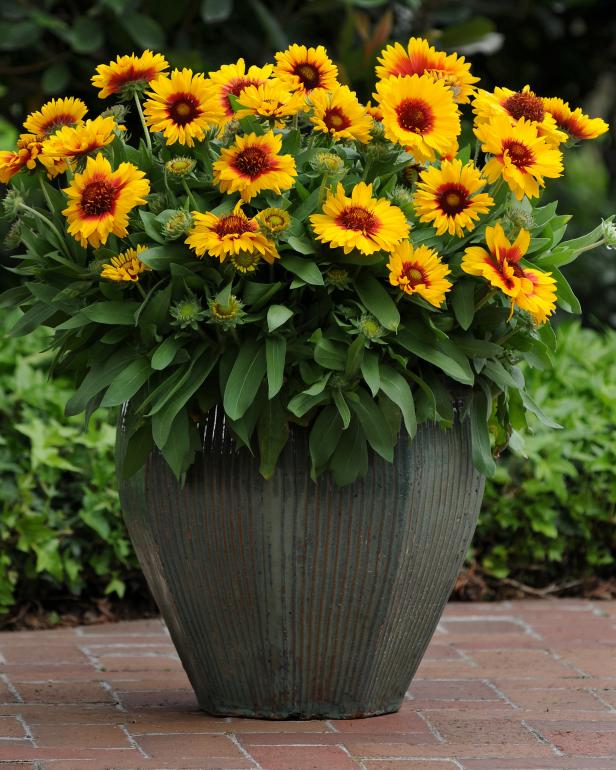
Ball Horticultural Company
Because the flower show is so strong and colorful, blanket flower can easily hold its own in a container. This beauty is Mesa Bright Bicolor blanket flower (Gaillardia x grandiflora). Plants grow 14 to 16 inches tall and 20 to 22 inches wide. Hardy in Zones 5-9.
Feeding
Once blanket flower plants are established in your landscape, they don't need much fertilizer. For established perennial blanket flower plants, fertilize in spring as new growth begins. You can accomplish this ideally by adding a 1- to 2-inch-thick layer of compost around plants or applying a commercial fertilizer for perennials. For newly planted blanket flowers in planting beds, fertilize at planting time by mixing a slow-release product into soil.
For blanket flowers in containers, mix a slow-release fertilizer into soil prior to planting. Choose a fertilizer with low numbers, such as 3-1-2, 6-2-4 or 9-3-6, and use it at half the rate suggested on the label. Plan to add more to the top of soil in six to eight weeks, gently scratching it into the soil. Skip bloom booster-type products.
Winter Care
As long as soil drainage is good, most blanket flower plants survive cold to -20° F without any extra mulch or even snow cover.
Do you cut back blanket flower in the fall? Many gardeners in coldest zones report improved winter survival by cutting blanket flower plants back to about 6 inches in late summer.

Terra Nova Nurseries at TerraNovaNurseries.com
Bold blossom colors probably earned blanket flower its name, according to one story that says these bright flowers carpeted the grave of a revered Native American blanket weaver. This variety is ‘Sun Flare’ blanket flower (Gaillardia x grandiflora).
For blanket flower plants in containers, you have two options for overwintering.
Leave the plant in containers and shift them into an unheated garage or shed. Water occasionally through winter to keep roots alive.
The other choice is to transplant your blanket flowers into a planting bed or empty vegetable garden for winter. Aim to do this a minimum of six weeks prior to hard frost in your area. Once the ground freezes, mulch soil well.
Types of Blanket Flowers
Plant breeders have been creating wonderful varieties of blanket flowers with different flower colors, plant sizes and petal forms. Here are several of our favorites.
'Sun Flare' Gaillardia — Trumpet-shaped petals sizzle with multiple colors. Plants grow 8 to 10 inches tall and 20 inches wide. Hardy in Zones 3-9.
'Arizona Sun' Gaillardia x grandiflora — A 2005 All-America Selections winner, this blanket flower features large, 3-inch-wide blooms. Plants grow 8 to 10 inches tall and up to 10 inches wide. Hardy in Zones 3-10.
Mesa Gaillardia — The 'Mesa' blanket flowers grow well from seed. Look for varieties in shades of yellow, peach, red and fun bicolor blends. Plants grow 14 to 16 inches tall and 20 to 22 inches wide. Hardy in Zones 5-9.
'Sun Devil' Gaillardia — Fluted red petals feature bold yellow tips. Plants grow 8 to 14 inches tall and 10 to 12 inches wide. Hardy in Zones 3-9.
How to Use Blanket Flower in the Landscape
Blanket flowers are versatile and can fill many roles in the garden. Some of the best ways to use blanket flower include:
- Massed as an edging plant at the front of beds (compact varieties)
- Wildlife garden
- Prairie garden (plant with yarrow, Baptisia, Liatris, coreopsis and purple coneflower)
- Butterfly garden
- In a container solo or mixed with other plants
- Cottage garden (intermingled with blue or purple flowering plants)
- Cutting garden
Blanket Flower FAQs
Do I need to deadhead blanket flower?
Technically, no, you don't have to remove spent blanket flower blooms, but doing so will keep the plant from setting seed and may encourage more flowers to form. Near the end of the growing season, let some flowers go to seed for birds to eat and for you to sprinkle around the plant to increase the size of your blanket flower patch.
How long do blanket flowers last?
Blanket flowers are known as short-lived perennials. The average lifespan for Gaillardia x grandiflora varieties is about two years. Divide plants at the two-year mark to keep the clump strong. Plan to add new plants every few years, or simply scatter seed from existing blanket flowers in areas where you want them to grow.
Do blanket flowers spread?
Blanket flowers are not aggressive growers, but will spread by self-sowing (dropped seed sprouts and forms a new plant). Baby blanket flowers look like dandelions, so it's a good idea to learn to identify the seedlings so you don't accidentally pull them when weeding.
Is blanket flower a good ground cover?
Because blanket flower is a short-lived perennial, it's not a great choice for a flowering ground cover. Some varieties spread somewhat, so they can fill the role in that sense, but it's not long-lasting like creeping phlox or low growing sedum.

.-Battle-on-the-Beach-courtesy-of-HGTV.-.jpg.rend.hgtvcom.196.196.suffix/1714761529029.jpeg)





